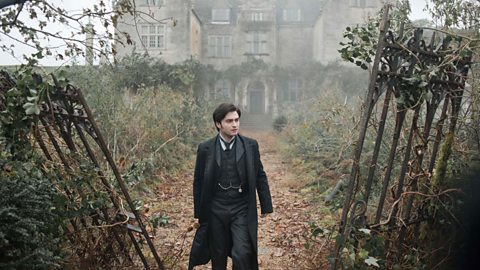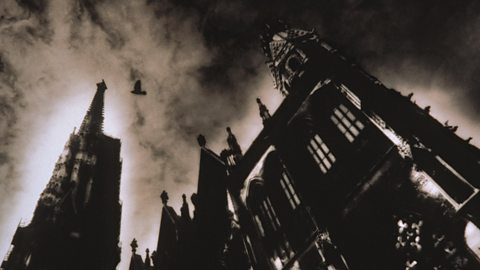Arthur Kipps in The Woman in Black
- rational
- determined
- haunted by the past

Arthur Kipps is the main character and narrator of the story. We see him as a contented man at the start of the novel, but he is haunted by memories of his past. As he narrates his own ghostly tale we are first presented with a rational, keen and positive young man. He is determined to complete his work at Eel Marsh House, no matter how strange or scary the place is. He maintains his optimistic streak even after being haunted to a state of fevered terror. He hopes that he will be the last person the Woman in Black will torment.
At the end of the story his first wife and son are killed after he sees the ghost of Jennet Humfrye (The Woman in Black) one more time and finally we understand his unwillingness to share his tale on Christmas Eve.
| How is Kipps like this? | Evidence | Analysis | |
| Haunted by the past | When his step-children press him to tell a ghost story on Christmas Eve, Arthur is so disturbed by the memory of his experience that he runs from the house. | I came to my senses and found myself on the scrubland beyond the orchard, my heart pounding, my breathing short. | Arthur is physically affected by thoughts of his ghost story. His rapid heartbeat and short breath are signs of adrenaline, showing the reader that he is in a heightened state of fear. |
| Rational | The young Arthur Kipps is unafraid at his first sighting of the Woman in Black, even when Mr Jerome is almost faints with fear. | Behind me were only a school of little children, and a mortally sick young woman under great emotional and physical strain, beside me was a man in a state of near-collapse. | Arthur's rational response to what he sees is contrasted with Mr Jerome's dramatic reaction. This raises the tension for the reader. |
| Determined | His persists with his daunting task of sorting Mrs Drablow's papers, even after being scared in the night by mysterious bumping noises. | "Well," I said, "I'm not going to be put out by a ghost or several ghosts, Mr Jerome." | Arthur Kipps' determination to complete his task allows him to override his fears and to 'make light' of the hauntings. |
| Optimistic | Arthur sometimes seems blindly optimistic, finding the positive side to the most daunting situations. | Otherwise, I rather liked this lonely spot, and thought how it would be on a warm evening at midsummer. | Although he has arrived at Eel Marsh House on a cold, grey, windy day, he is able to imagine it in a positive light. This suggests a likeable naivety about his character. |
| Haunted by the past | |
|---|---|
| How is Kipps like this? | When his step-children press him to tell a ghost story on Christmas Eve, Arthur is so disturbed by the memory of his experience that he runs from the house. |
| Evidence | I came to my senses and found myself on the scrubland beyond the orchard, my heart pounding, my breathing short. |
| Analysis | Arthur is physically affected by thoughts of his ghost story. His rapid heartbeat and short breath are signs of adrenaline, showing the reader that he is in a heightened state of fear. |
| Rational | |
|---|---|
| How is Kipps like this? | The young Arthur Kipps is unafraid at his first sighting of the Woman in Black, even when Mr Jerome is almost faints with fear. |
| Evidence | Behind me were only a school of little children, and a mortally sick young woman under great emotional and physical strain, beside me was a man in a state of near-collapse. |
| Analysis | Arthur's rational response to what he sees is contrasted with Mr Jerome's dramatic reaction. This raises the tension for the reader. |
| Determined | |
|---|---|
| How is Kipps like this? | His persists with his daunting task of sorting Mrs Drablow's papers, even after being scared in the night by mysterious bumping noises. |
| Evidence | "Well," I said, "I'm not going to be put out by a ghost or several ghosts, Mr Jerome." |
| Analysis | Arthur Kipps' determination to complete his task allows him to override his fears and to 'make light' of the hauntings. |
| Optimistic | |
|---|---|
| How is Kipps like this? | Arthur sometimes seems blindly optimistic, finding the positive side to the most daunting situations. |
| Evidence | Otherwise, I rather liked this lonely spot, and thought how it would be on a warm evening at midsummer. |
| Analysis | Although he has arrived at Eel Marsh House on a cold, grey, windy day, he is able to imagine it in a positive light. This suggests a likeable naivety about his character. |
Social and historical context

The novel follows a literary tradition of that typically include isolated houses or castles, hauntings and induce fear in the reader. Susan Hill explains that she set out to write a ghost story, inspired by her love for Henry James' novel, The Turn of the Screw. She read a range of ghost stories to inspire her and made a list of elements that a ghost story should contain. One of the key features of these stories, as well as the ghost itself, is a 'most unimaginative and straightforward' person who 'most certainly did not believe in such things as ghosts'. We see this character clearly in the rational Arthur Kipps.
Analysing the evidence
I had walked about in a frenzy of agitation, and now, realising that I must make an effort to calm myself, I sat down on a piece of old, moss-covered stone, and began to take deliberate, steady breaths in on a count of ten and out again, until I felt the tension within myself being to slack and my pulse become a little steadier, my head clearer.
Question
How does Susan Hill show Arthur Kipps is upset at the start of the novel?
'I had walked about in a frenzy of agitation, and now, realising that I must make an effort to calm myself, I sat down on a piece of old, moss-covered stone, and began to take deliberate, steady breaths in on a count of ten and out again, until I felt the tension within myself being to slack and my pulse become a little steadier, my head clearer.'
- sentence length - this is one very long sentence, punctuated by commas. It seems to convey a sense of breathlessness in its structure. (Try reading it aloud to get the feel of it!)
- 'a frenzy of agitation' - both these words suggest restlessness. The use of two words here with a similar meaning emphasises Arthur's inner turmoil.
- 'old, moss-covered stone' - Susan Hill uses Gothic images like this throughout the story, reinforcing the genre and adding to an unsettling ghostly atmosphere.